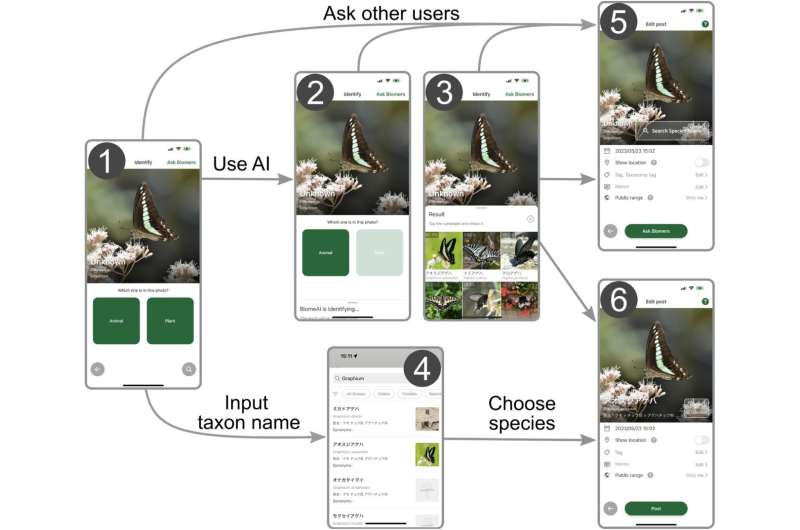This article has been reviewed according to Science X's editorial process and policies. Editors have highlighted the following attributes while ensuring the content's credibility:
fact-checked
peer-reviewed publication
trusted source
proofread
Crowdsourced data provides accurate biodiversity picture to aid conservation efforts

Data collected by people recording wildlife on their smartphones could improve biodiversity monitoring and help to prevent global nature loss, according to a new study.
The research, published today as a reviewed preprint in eLife, was described by editors as an important study that uses citizen science-generated diversity records and quantitative methodologies to improve species distribution estimates.
This combination of fields, technologies, and methodologies is solid and improves species distribution maps formerly based solely on limited data gathered by scientists using traditional surveys.
The research will be of interest to researchers interested in citizen science and new sources of big data in biodiversity, and to biogeographers exploring the distributions of species on the planet.
Ecosystems—and their direct and indirect contributions to human society—have been rapidly declining in recent years. To address this, the United Nations Kunming-Montreal Global Biodiversity Framework (KM-GBF) has a target of protecting 30% of Earth's land and ocean area by 2030 (30x30) and requires companies to monitor and transparently disclose their impacts on biodiversity. To do so, it's essential to accurately assess the state of biodiversity over space and time, with sufficient resolution to support conservation planning.
"Traditionally, our knowledge of species distributions has been acquired by experts conducting on-site surveys, but collecting distribution data with sufficient spatiotemporal resolution is challenging if we rely only on limited human resources," explains lead author Dr. Keisuke Atsumi, Data Scientist at Biome Inc, Kyoto, Japan.
"Since the emergence of digital devices and the internet, people have been sharing their observations of the natural world through images and recordings, providing a crowdsourced supply of data. We wanted to see whether these data could improve existing statistical models used to predict the impact of climate change and changes in land use."
"In 2019, we launched the mobile application Biome in Japan, to fuel communities' engagement in biodiversity surveys and environmental education," says senior author Shogoro Fujiki, Chief Executive Officer of Biome Inc. "Biome uses artificial intelligence to help users identify species but also has a game-element where players can earn points by helping others to identify species."
Since its launch, Biome has attracted a large crowd of citizen scientists who together have collected 6 million occurrence records for different species—four times greater than the number of records accumulated by the Global Biodiversity Information Facility in the same time period in Japan—the traditional source of this data. What the researchers didn't know was, are the data as good as those collected by conventional means?
To test this, they evaluated the species identification accuracy of the Biome data by using traditional survey data—i.e., the experts. After filtering the crowdsourced data for invalid records and excluding non-wild individual species, they found the species identification accuracy was greater than 95% across amphibians, reptiles, birds and mammals, and 90% for seed plants. This led them to test whether combining the two sources of data would give better predictions of biodiversity at specific sites.
Species distribution models (SDMs) are effective statistical tools for assessing biodiversity at specific sites. They use species occurrence records and environmental conditions to estimate the potential geographic ranges and suitable habitats for species. The researchers built two SDMs—one using only traditional biodiversity surveys and a second using traditional survey data plus crowdsourced data.
The SDMs using both datasets were more accurate than those only using traditional survey data, when each dataset had the same number of species occurrence records. When compared to SDMs using only traditional survey data, those using both datasets achieved a high level of accuracy with less data overall.
Although there are some limitations, such as only using data from Japan and only being able to include data on the presence of species and not the absence nor abundance, the rapid accumulation of crowdsourced biodiversity data could make a significant contribution to more effective modeling of biodiversity and endangered species.
"Engaging a broader spectrum of stakeholders is crucial for effective biodiversity assessment, nature management planning and nature-related industry disclosures," concludes Fujiki. "We believe that community science can significantly contribute to creating a sustainable society by fostering nature-positive awareness in society and providing data tools that enable effective action."
More information: Keisuke Atsumi et al, Boosting biodiversity monitoring using smartphone-driven, rapidly accumulating community-sourced data, eLife (2024). DOI: 10.7554/eLife.93694.1
Journal information: eLife
Provided by eLife




















